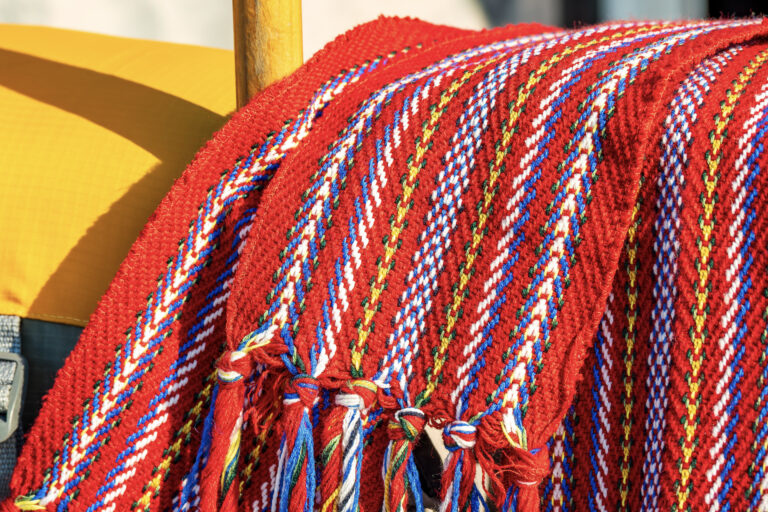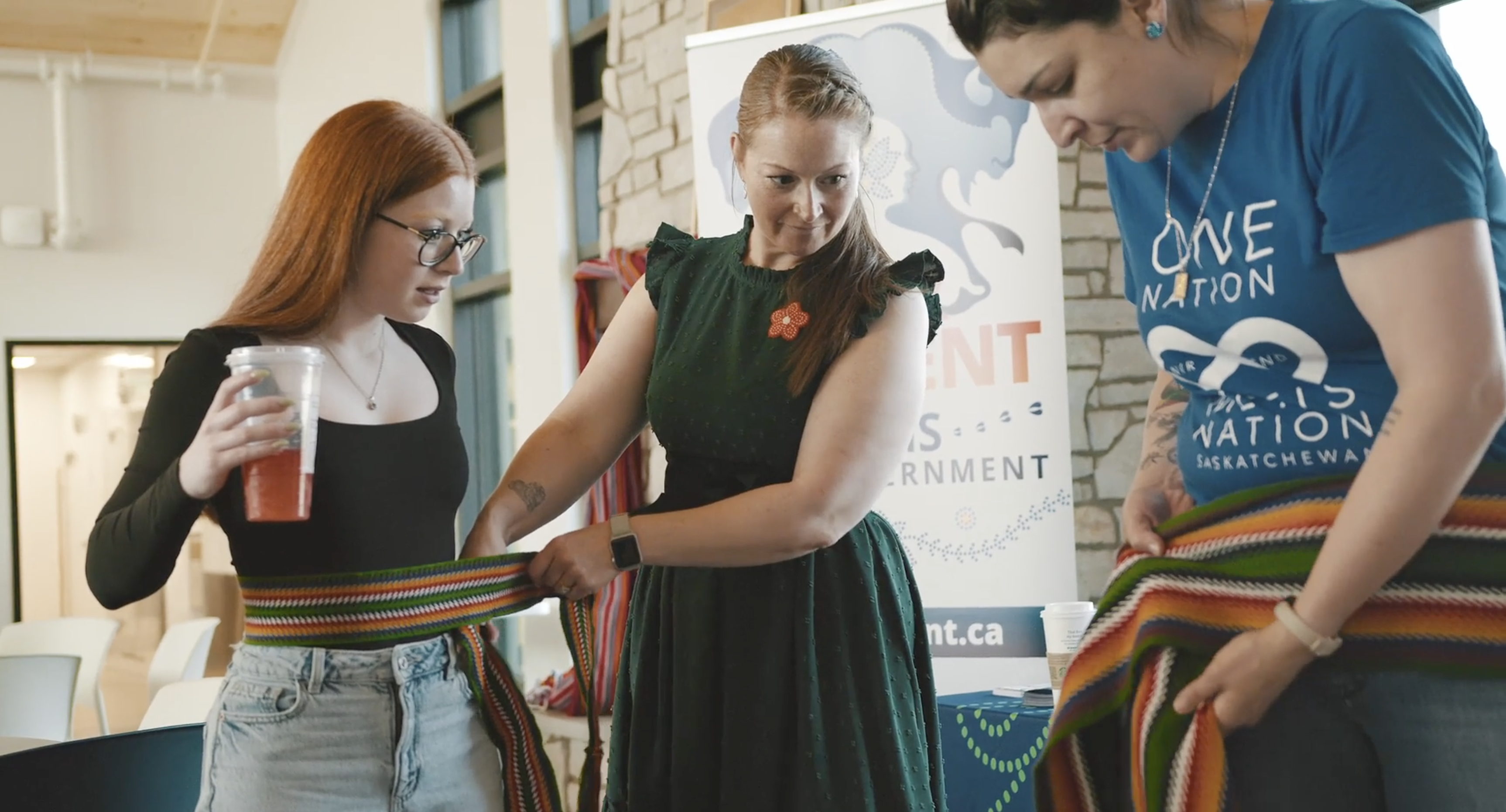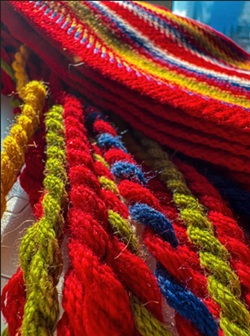History & Culture
Traditional Dress
Our Métis Identity Expressed in Design and Clothing
Throughout history, Métis people have demonstrated a rich tradition of innovation and creativity in our design and clothing. Even today, cultural symbols and designs unify and connect our people. Our decorative arts show our diverse cultural inheritance and influences from French-Canadian, Scottish, English, and First Nations such as Cree and Ojibway peoples.
Métis clothing construction and designs from the early fur trade were considered innovative, blending different techniques and mediums into new expressions. Although Métis fashion continues to evolve and adapt, many modern Métis designers look to the past for guidance and inspiration. Métis designers like Lisa Sheppard from British Columbia and Christine Tienkamp from South Saskatchewan River Designs are two examples of contemporary Métis innovators reinterpreting traditional designs.
Métis Style Beadwork – The Flower Beadwork People
Métis style beadwork is the pride of the Métis Nation. Through it we express our identity to the world. Our many beautiful floral patterns show our connection to the land and to each other. The Dakota Sioux people called the high plains Métis, “The Flower Beadwork People,” a nod to our flowing style of beadwork which stands in stark contrast to their geometric quillwork.
Sherry Farrell–Racette and Christi Belcourt share their knowledge of “The Flower Beadwork People” through art, research, and stories. Their art and written teachings are examples of the importance and uniqueness of Métis flower beadwork. These teachings continue to be taught in Métis communities and families. New generations of Métis are using this form of traditional art in modern ways to express themselves and tell their own stories. Educational institutions such as the Gabriel Dumont Institute and the Louis Riel Institute have created instructional manuals to support Métis people and others who want to learn floral beadwork.

Weaving History – The Story of the Métis Sash
Origin:
The Métis sash is a finger-woven wool belt that has become one of the most recognizable symbols of Métis identity. Originating in Eastern Canada, particularly in L’Assomption, Quebec, the sash was initially worn by Métis, Canayens, and First Nations voyageurs as early as the late 1600s. By the early 1800s, it had become an emblem of Métis pride in the Northwest, reflecting the Métis’ deep involvement in the fur trade. Worn traditionally and ceremonially, the sash often measured around three meters long (sometimes up to six metres), and its design was highly individualized. Specific patterns and colours on a sash could identify a person’s family or home community. The sash remains central to Métis recognition today. The Order of the Sash is considered the highest honour awarded by many Métis organizations.
How it is Worn:
There are many ways to wear a sash, each with its own meaning. The traditional ways the sash was worn were across the heart for women and across the waist for men. Over time, traditions have evolved, and with new understandings of gender, gender roles, and gender identity, individuals should wear the sash according to their preference. The sash has both practical and ceremonial uses. A standard sash can be used as a tool or for play. There are some instances where a sash is given as an honour or in ceremony. These ceremonial sashes can still be used like the previously mentioned standard sashes; however, the weaver typically spends much more time customizing and perfecting these sashes.
Practicality:
Beyond its cultural and symbolic values, the sash was a highly practical garment. It served multiple functions, such as back support for voyageurs to prevent hernias, a belt to hold coats closed or carry tools, and even as an emergency sewing kit using the fringe threads. It could act as a rope, towel, washcloth, sling, or saddle blanket. It could be used as a marker during buffalo hunts, and it could even be used to transport water. The sash also served mathematical purposes, functioning as a calendar to track the days of a long journey, or even as a type of calculator. The sash can also be used to help teach individuals to dance. When the sash is laid on the ground in an “X” formation, teachers can easily instruct on where to step around the sash (laying the sash on the ground in this context is not harmful or disrespectful to the sash).
Weaving:
The weaving process was very labour-intensive, with high-quality sashes taking up to 200 hours to complete. A modern interpretation of the sash is that each colour weaved within the sash carries deep meaning: red for the blood shed by the Métis in defense of their rights, black for the dark period of colonization and cultural loss, and other colours like blue, green, white, and yellow symbolizing spirit, growth, connection to the earth, and prosperity. Depending on the community, the meanings of the sash colours may vary. In Heritage Michif, the sash is called sayncheur flayshii, and it continues to be a powerful living emblem of Métis resilience and identity. In modern times, many sashes are machine-woven, but the refined and highly respected art of finger weaving is still practiced by many proud Métis.
Wrapped in Our Métis Identity – The Capote Jacket
As the fur trade continued, blankets became a popular item among the Métis. Many families acquired them via trade from the Hudson Bay Company (HBC) and the Northwest Company (NWC). It became a cultural practice among our Métis ancestors to make a special wool coat called a Capote from these blankets. The Capote jacket was expertly designed to be breathable and flexible for comfortable movement when trapping, hunting or working the land.
Métis women created the Capote pattern with unique decorative features that made Métis traders easily identifiable in society. The blankets that were used told the story of our Métis families and their trade affiliations.
Today, the Capote jacket is making a resurgence in contemporary Métis communities because of its symbolic origins. Métis Elder Joanna Potiyandi (Blondeau) from Southern Saskatchewan, teaches this almost forgotten art form and makes our traditional clothing wearable and visible once again. One of Joanna’s Capote jackets is part of the Gabriel Dumont Museum collection in Saskatoon, Saskatchewan.
Emily Hearn (Beading Our Identity: “The Flower Beadwork People”, Guelph Arts Council)“And so we, the Métis, beaded ourselves into the fabric of Canada’s history.”
Métis Style Gauntlets – Belonging in Design
Among other things, living off the land in Canada requires warm and durable clothing. Métis traditional land users such as dog mushers, those who gather wood for heat, trappers and hunters, maintain a lifestyle that leaves them exposed to all types of extreme weather. Proper attire such as mitts or gauntlets are a must for these land-based practices and jobs.
Over time, Métis people have inherited unique mitten designs to create gauntlets. Gauntlets are a durable form of traditional clothing made mainly from moose hide. Métis author and children’s book illustrator, Leah Marie Dorion explains the cultural significance of these forms of clothing in her book, Métis Christmas Mittens. Dorion explains that pom-poms, tassels, beadwork, and fringe are examples of Métis decorative elements. And although they emerged during the early fur trade, many of these elements can still be seen today on cultural clothing such as gauntlets and mittens. Warm, Métis designed, traditional clothing is a source of pride for our Nation.
Love in Every Stitch – Métis Embroidery
According to the teachings of our Métis Elders, when we hand make clothing, it is important to put love into every stitch. Decorating our clothing with embroidery is a traditional art form inherited by the Métis. Métis women first learned embroidery from the church and obtained silk thread from the fur trading posts. Because of the flexibility inherent in embroidery and how light it was compared to bead work, silk embroidered traditional clothing became a favoured design among the Métis for many years.
Over the years, the Anglican church accumulated many silk embroidered items from northern Métis communities. From 1899-1950, Anglican Archdeacon Richard Fairies was stationed in Cumberland House, Saskatchewan. During that time, he collected the embroidery work of many local Métis women. Those artifacts are now on display at the Thunder Bay Museum in Ontario in a collection titled, “Little Spirits on a Thread.”
Today, Métis Elder Margaret Harrison from Saskatchewan is working with the Gabriel Dumont Institute to teach and preserve this form of decorative art. Margaret also makes videos explaining the history of Métis Style Rug Hooking, another form of Métis women’s artistic expression.
Emelia Villebrun, an artist and educator, was taught traditional crafts and values through family sewing circles. She was greatly influenced by her mother, herself an accomplished artist who was highly skilled in creating traditional garments and crafts (read Emelia’s full bio here). In the video below, Emelia discusses traditional crafts and traditional clothing as she walks us through the process of creating Métis mannequins with traditional Métis garb.
Click here to read more about the artistic process that led to the creation of these unique works of art.



